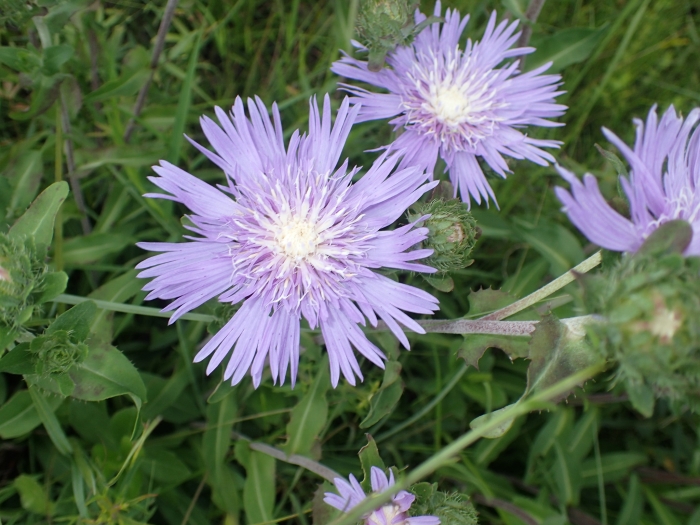Stokes’ Aster
(Stokesia laevis)
Stokes’ Aster (Stokesia laevis)
/
/

mfeaver
CC BY 4.0
Image By:
mfeaver
Recorded By:
Copyright:
CC BY 4.0
Copyright Notice:
Photo by: mfeaver | License Type: CC BY 4.0 | License URL: http://creativecommons.org/licenses/by/4.0/ | Rights Holder: mfeaver | Publisher: iNaturalist | Date Created: 2020-06-11T12:15:58-07:00 |








































































Estimated Native Range
Summary
Stokesia laevis, commonly known as Stokes’ aster, is a perennial herb in the daisy family native to moist meadows, savannas, and open woodlands of the southeastern United States. It typically grows to a height of 1-2 feet (30-60 cm) and a similar width, with a mounded form. The lance-shaped leaves are medium green, and the plant is known for its showy flowers which bloom in summer. The flowers are large, up to 3 inches (7.6 cm) across, with a fringed appearance and come in shades of purple, blue, or white. Stokes’ aster is valued for its attractive flowers and long blooming period, making it a popular choice for borders, butterfly gardens, and as a cut flower.
Stokes’ aster thrives in full sun to part shade and prefers well-drained soil with consistent moisture. It is drought-tolerant once established, making it suitable for xeriscaping. Deadheading spent flowers can encourage additional blooming. The plant is generally low-maintenance, but it can be susceptible to root rot in poorly drained soils and may suffer from powdery mildew. Cultivars offer a range of colors and forms, with ’Klaus Jelitto’ featuring cornflower blue flowers, ’Colorwheel’ transitioning from white to purple, ’Blue Danube’ with blue flowers and a white center, ’Rosea’ with pink flowers, and ’Mary Gregory’ with yellow blooms.CC BY-SA 4.0
Stokes’ aster thrives in full sun to part shade and prefers well-drained soil with consistent moisture. It is drought-tolerant once established, making it suitable for xeriscaping. Deadheading spent flowers can encourage additional blooming. The plant is generally low-maintenance, but it can be susceptible to root rot in poorly drained soils and may suffer from powdery mildew. Cultivars offer a range of colors and forms, with ’Klaus Jelitto’ featuring cornflower blue flowers, ’Colorwheel’ transitioning from white to purple, ’Blue Danube’ with blue flowers and a white center, ’Rosea’ with pink flowers, and ’Mary Gregory’ with yellow blooms.CC BY-SA 4.0
Plant Description
- Plant Type: Herb
- Height: 1-2 feet
- Width: 1-1.5 feet
- Growth Rate: Moderate
- Flower Color: Blue, Purple, White
- Flowering Season: Spring, Summer, Fall
- Leaf Retention: Deciduous
Growth Requirements
- Sun: Full Sun, Part Shade
- Water: Medium
- Drainage: Medium, Fast
Common Uses
Bee Garden, Bird Garden, Border Plant, Butterfly Garden, Deer Resistant, Drought Tolerant, Fragrant, Groundcover, Hummingbird Garden, Low Maintenance, Potted Plant, Rabbit Resistant, Rock Garden, Showy Flowers, Street Planting
Natural Habitat
Moist meadows, savannas, and open woodlands in the southeastern United States
Other Names
Common Names: Stokesia, Stokesie, Kornblumenaster, Aster Centaurée, Stokésia, Blåklintsaster
Scientific Names: , Stokesia laevis, Stokesia cyanea, Carthamus laevis, Cartesia centauroides, Carthamus cyaneus,
GBIF Accepted Name: Stokesia laevis (Hill) Greene